
Related
Topics
Guests
- Mansoor Adayfiformer Guantánamo detainee who was imprisoned without charge for 14 years and seven months before being released in 2016 to Serbia. He is the Guantánamo Project coordinator at CAGE, an organization that advocates on behalf of victims of the “war on terror,” and outreach coordinator for the Guantánamo Survivors Fund.
In Part 2 of our interview with former Guantánamo detainee Mansoor Adayfi, he discusses how he and others who have been released are calling on Biden to let them keep the artwork they produced during their years in captivity, and what the art means to them. The current policy lifts Trump’s complete ban, but the formerly detained men can only take “a practicable quantity of their art.” “Art actually connected you to yourself, to your memories, to who you are. It was our secret way to escape the pain … of being in prison,” says Adayfi. “What is the right for the government to hold the art?” he asks.
Transcript
AMY GOODMAN: This is Democracy Now!, democracynow.org, The War and Peace Report. I’m Amy Goodman, as we bring you Part 2 of our conversation with Mansoor Adayfi, the former Guantánamo prisoner, Detainee 441, imprisoned without charge for 14 years and seven months before being released in 2016 to Serbia, though he was from Yemen. The U.S. government labeled him the, quote, “worst of the worst,” yet he was never charged. His memoir is titled Don’t Forget Us Here: Lost and Found at Guantánamo. He’s now the Guantánamo Project coordinator at CAGE, an organization that advocates on behalf of victims of the “war on terror.” He’s also the outreach coordinator for Guantánamo Survivors Fund.
He has a new piece for The Guardian. It’s headlined “For all of us detained at Guantánamo, making art was a lifeline. Why won’t Joe Biden let us keep our work?” In it, Mansoor writes, “Last month, the Pentagon partially lifted the Trump administration’s ban on the release of artwork made by prisoners at Guantánamo Bay. Prisoners will be able to take 'a practicable quantity of their art' if they are transferred out of the prison. It’s unclear what 'practicable' means, and whether this ambiguous term means prisoners will only be allowed to take a small portion of the artwork they have created during years of captivity,” unquote. Again, the words of Mansoor Adayfi.
Mansoor Adayfi, joining us now from Belgrade, can you lay out what is happening with the artwork over the years and what you’re calling for now under the Biden administration?
MANSOOR ADAYFI: Yeah. Thank you, Amy. You know, the art story is an amazing art [inaudible]. At the beginning, early days at Guantánamo, we weren’t allowed to have any books or pens or paper or anything. So, we started, you know, using the plastic fork to draw on the styrofoam clamshells or cups. Sometimes we used the powder tea that came with the —
AMY GOODMAN: MREs?
MANSOOR ADAYFI: MREs, yes, sorry. MREs. So, we used the powder tea to draw on the toilet paper they gave us. And that, we will get punished. Stuff will be confiscated and will be used as, like, evidence. They are said — they kept as evidence. They will bring cameras, interpreters. All the stuff will put, like, bags and will be taken away.
So, we weren’t allowed to have any kind of classes or anything. Sometimes there was like some artists among us. They would give, like, artificial — sorry, they will give like theoretical classes. But we had another form, like dancing, singing. It was also like poetry, poems, and so on. This is how — this is also another form of art. Even when we get to sing, then we will get punished, because we sing, like, collectively, and it would sound loud, and our guard will close the windows. They will bring, like, vacuums, loud fans to stop us, because they took it as a challenge. So, that lasted until 2010.
When Obama failed to close Guantánamo, we were also force-feeding and hunger strike. We negotiated with the camp administration to improve living conditions in the camp. And they sat with us — for the first time, they sat with us, and they actually shake hand with us. And it was like — we were making fun of them, because before they said, “We don’t negotiate with terrorists,” then now, in 2009, they came, shake hand with us. And we’re talking about opening communal living, classes, family phone calls, better healthcare. And one of the classes we negotiate was art class.
So, the art classes start in 2010. Then, by the end of 2010, we got an art teacher. He has a — an Iraqi art teacher. He has, like — he has a Ph.D. in art. Then we started going to the class. We start. We get, like, colors. We get, like, art materials from our lawyers, from families. Then we started painting. That lasted until 2013. Again, when the Army took over of the camps, many of the arts were destroyed or confiscated. And again, like, we had to go on hunger strike again and force-feeding to improve the living condition again. So, and the camp administration allow art to leave Guantánamo either through the ICRC or through our lawyers. We will send art to our families. We even gave arts to guards, camp stuff.
You know, making art, it was like a way to survive at Guantánamo, because the more we stayed in Guantánamo, the more we distanced from our previous life, from our memories, from our families, from the life that we knew. So, when we start making art, we started, you know, painting the things that we missed most, like the blue beautiful sky, the stars, the sea, a sea special story, and, like, flowers. You know, art actually connected to yourself, to your memories, to who you are. It was our secret way to escape being in Guantánamo, to escape the pain of being in prison. And there was a lot of arts was produced and get only better and better. So, like other prisoners, I sent — I gave my paintings to my lawyer.
In 2017, with a professor, Erin Thompson, we organized an art exhibition in New York at John Jay College. That’s when the Pentagon or Department of Defense announced that they are going to burn our art from Guantánamo, this art belongs to the government. And at that time, we know Trump was the president of the United States. His administration banned art from leaving Guantánamo. They also stopped the — they also, you know, temporarily stopped the art classes at Guantánamo. Ironically, the camp administration, in 2010, they created their own art gallery at Guantánamo, a small room, for tourists and visitors and journalists to show them that how we are treated actually. Actually, our art was used to improve the U.S. image of Guantánamo.
AMY GOODMAN: Wow!
MANSOOR ADAYFI: Since — yeah. Since 2017, we started now fighting, you know, for the release of art from Guantánamo. I wrote letter to DOD. Then we reached out to the — we also wrote former Guantánamo prisoners. We wrote a letter to Biden to release art from Guantánamo. And with the lawyers, we reached out to the United Nations. So, when the United Nations gets involved, you know, before the U.N. rapporteur visits Guantánamo, the Pentagon announced that they will allow like a practicable amount from art from leave Guantánamo. And that was good news, but it’s not enough. So, now we are still like with lawyers also trying to — because what’s the right for the government to hold the arts? Like, the paper and pens or the colors? What about the copyright? What about the detainees’ or prisoners’ intellectual?
So, recently, there’s a prisoner who was released from Guantánamo, Rabbani. He is also one of the artists. They allow him to take all of his art except the drawing he drew about his time in the black site. And this is a good sign, but there is no guarantee other prisoners were allowed to have their own sculptures, because Moath is working in actually another ship, as you see the ship, the mothership he did in Guantánamo. He did a few of them. And now my lawyer told me he — they gave him some piece of wood, and he’s making a bigger one. And I hope they allow him to take it with him.
So, art actually connect us. It doesn’t just belong to the prisoners. It belongs to all humanity, because arts, you know, it is — it belongs to all of us. At the same time, we would like the world to see art from Guantánamo. There is a website called ArtFromGuantanamo.com. Yeah.
AMY GOODMAN: Well, Mansoor, in your piece for The Guardian, you highlight some of your own art and the art of others. And you just mentioned the ships. You write, “In the instance of some model ships made by Moath al-Alwi, troops went so far as to make and study an X-ray of them.” I mean, these ships are amazing. The New York Times did a six-minute video on the ships made by al-Alwi. Describe what happened with these.
MANSOOR ADAYFI: Yeah, art from Guantánamo, like, when we paint, we weren’t sure that our art will be authorized, because we spend some of the paintings took weeks, months — some, some years — because we weren’t allowed to have only 45 minutes, twice a week, and all the stuff has to stay at the classroom. So, it was like racing with time. When we were painting, we weren’t allowed — we wouldn’t — we didn’t know it, because the art has to go through the process for approving. You paint a painting. You give it to the teacher. The teacher will give it to the class officer. Then it has to go to the DTF officers. They will go through it. They will scan it for any kind of like poison materials, secret codes, you know, any kind of things that might symbols. If that painting allowed, it will be given a number, and it would have a stamp by “approved by U.S. Army.” If not, it will be sentenced to this — you will never see it again. So, this is the way how art released from Guantánamo. As for the ships or boats that were made, has to go through the process X-rays. And, like, there is special people will examine it, and, like, it is a whole — a whole process, you know?
AMY GOODMAN: And the ship, in particular, what Moath al-Alwi was trying to do with these ships and why he focused on ships?
MANSOOR ADAYFI: You know, Moath, he’s really a unique artist, and ships means a lot to him. It’s like a way to survive the anger, the angry sea. And he saw himself as, like, lost in this wide or large ocean. The only way, he had to make this kind of ship, and always told me, like, he found himself while he was working on the ship. I helped him on the first one. It was a way, like, to — our making art or those ships, a way of, like, healing, a way of finding yourself. You have a way to — you have control over something.
AMY GOODMAN: And then, talk about your artwork. One of the pieces that are featured in your Guardian piece are simply flowers. Talk about the flowers and why they’re important to you.
MANSOOR ADAYFI: You know, flowers, it’s just like this symbol of the flourish life. You know, before any planet, before any tree give — and I think it has to go through the kind of like the flowers, give you like impression, the beautiful impression, what’s coming next. So, flowers, for me, it always give me hope. And it is always like something beautiful and nice is coming on the way. So I started drawing a lot of flowers, the sea and so on, yeah.
And I had also another drawing, which is like half-dead and half-alive, same flowers but half of it dead and half alive, and with a thin line, which is hope. And you can choose either to have, like, to have hope or to die, because you could exist without hope. You will be — you are not alive, but you actually physically exist. So, what kept us at Guantánamo, this kind of thin line of hope that one day we will leave Guantánamo, hope that there are always good people who are fighting for us and fighting for the right things and for the right cause.
AMY GOODMAN: Now, you didn’t just draw flowers. You also drew images. In Part 1, we talked about Florida Governor DeSantis, at the time a naval officer at Guantánamo, who you say oversaw your torture when you were being force-fed. And we also played the voice of another Guantánamo prisoner who said DeSantis was involved. He doesn’t write very much about this in his memoir as he prepares to run for president. But the image of being force-fed?
MANSOOR ADAYFI: You know, at Guantánamo, we weren’t allowed to — we didn’t have the freedom to paint whatever we wanted. If we did, you know, we would be suspended from art class, or sometime they would — they threaten us they will stop the art classes. So we had to choose, like, not to draw things that make them, like, angry or something like this. So, when — if we painted about hunger strike or about the way we were treated, I mean, that, we did sometimes, and they told us, “This the last warning. We are going to suspend the art classes.” So, we — and those paintings actually were confiscated. This painting was painted by Sabri al-Qurashi about the — like two years ago, about the force-feeding in Guantánamo, because Sabri was on hunger strike, and I asked him about, “Can you please draw about the force-feeding?” And he did.
AMY GOODMAN: And what about his Statue of Liberty? That’s the Guantánamo prisoner Sabri al-Qurashi.
MANSOOR ADAYFI: Yeah, it means like the statue like wearing an orange suit that actually it represents how United States — it actually is the expression of freedom at Guantánamo. It’s like being held — it’s like controversial — controversion of this liberty of freedom. There is a lot of of painting like this, where there’s like the Statue of Liberty, like, being hooded, gagged, you know, being, like, interrogated, being, you know, chained. It all, like, refers to the Guantánamo and the way prisoners were treated.
AMY GOODMAN: You know, in your piece, you talk about al-Alwi, another of the prisoners, cleared for release in January 2022, telling his lawyers he would rather his artwork be released than himself. He said, “As far as I am concerned, I’m done, my life and my dreams are shattered. But if my artwork is released, it will be the sole witness for posterity.” Can you —
MANSOOR ADAYFI: I mean —
AMY GOODMAN: If you can respond to that and also describe where you would do this artwork? And was it a time where you were all together? And just the idea, what you’re saying, the materials you used, anything you could get your hands on. And who were the art teachers?
MANSOOR ADAYFI: Yeah, the —
AMY GOODMAN: As if you needed to be taught.
MANSOOR ADAYFI: You know, the arts, we had — first of all, the art classes started in one of the blocks. It was like one in Camp 6, after, like — that started in 2010, after the living condition improved in the camp. And I call it the golden age. I describe that in my book. And at the beginning, we didn’t have art teacher. So, again, we had to demand with the camp administration to bring the art teacher, and they brought an Iraqi art teacher. His name is Adam. He was an amazing person. He’s an artist. Even in his character, the way he treated prisoners, he was very supportive. And he was like — he wanted to help everyone to paint.
So, then, later in 2011, there was like a classroom. And we’ll go to the class. We were chained to the floor. At the beginning, they free only one hand. Later on, they were allowed, like, to have two hand free, but we still chained to the floor. So, and then we started, like, building our skills in art, getting the art supplies from lawyers, from families, from the government.
Making the ships, you know, we would — we made a lot of stuff, like ships, cabinets, drawers, tables, and all of it was made of cardboard. We started using the soap to glue the pieces together. Later on, we were allowed to have glue and Velcro, so we started, again, like, cutting the — the guards actually helped in making that, because we weren’t allowed to have scissors. Guards always would cut. And one of the guards used to tell me, “Hey, Mansoor. Hey, 441, I’m going to call my mother to talk. I found another job and another boss,” because the camp administration ordered the guards to cut the cardboard, and sometimes they will get blisters, because they spend all day cutting. And we felt sorry. We said, “Yes, if you can get us the scissor, we will use it and give it back.” But it’s like orders. So, the guards will do the cutting, and we will do like the sanding, putting the pieces together.
Moath, he was like the — he’s the master of the work. He would come put the pieces together, glue it together. Then, after the ship or the other object is ready, we will put like — we would paint similar to wood, like, and we cover it with the — we will put the cover on the ships, as you see, and it would look exactly as it’s like wood. So, that whole process, you know, took a lot of time. We used plastics. We used the T-shirts, pray cups, the thread. We used anything. There is no thing called — nothing called trash at Guantánamo. Moath had two trash bags full of stuff — plastics, bottles. He was also on force-feeding, so the camp administration wanted to distract him. And he has like two bags of art materials, art — yeah, so, yeah, this the process making art and ships at Guantánamo. We are allowed to do anything in our cells. Everything has to be done in the classroom.
AMY GOODMAN: There are now 31 prisoners at Guantánamo, or detainees, as the U.S. government refers to them. I think “detainees” suggests, you know, there temporarily, but this has been going on for decades. Over 780 men have been held at Guantánamo. And I think the cost of holding a prisoner at Guantánamo is something like $13 million per prisoner per year. That was the estimate back in 2019. What are your thoughts about the advocacy groups, like, oh, Witness Against Torture, calling for Guantánamo to be shut down?
MANSOOR ADAYFI: Yeah, I would like to add one thing. When Moath sent his message to his lawyer about releasing his arts — even Khalid Qasim, he’s another artist — you know, this art means a lot to these prisoners, because art held part of their life, sacred memories. And this is their, you know, part of their life. Like, when Rabbani — when they destroyed Rabbani arts in 2013, I heard him screaming, like crying, “You are killing my children!” you know, because you feel you put some — you put your soul in this painting, and it meant like, become like your own child. So, yeah.
About as you said, Guantánamo cost taxpayer every year around like $540 million. And there is a lot of group advocacy, Witness Against Torture, Amnesty International, CAGE, others, who call for the closure of Guantánamo. And I think it’s — honestly, it’s for the best interests of the United States to close Guantánamo. Thirty men remain in Guantánamo. Seventeen have been cleared for release. And also there’s like three forever prisoners, one of them Abu Zubaydah, the forever prisoner, and I think all the world know about. So, Guantánamo shouldn’t exist in the first place. It has been over two decades, and there is no signs that the detention will be closed soon. Biden have released some of the prisoners, and I think they are working to release the ones who have been cleared.
And who knows what would happen to Guantánamo? Because talking to lawyers, watching the U.S. policy, Guantánamo, for them, is not priority, is not big deal, is not just — and also it turned to be a battlefield between — or, the battle, too, between the Democrats and the Republicans. You know, the Republicans want to keep it open. I don’t know for what reason. The Democrats want to close it. But there was like, as you know, the Congress put many obstacles of transferring prisoners to the United States. So it’s unseen, like, what’s going to happen to Guantánamo. Some of the lawyers said it’s not going to be closed. Some of us, we don’t know. And each administration, they have their own policy toward Guantánamo.
AMY GOODMAN: Finally, Mansoor, we’re talking to you in front of a backdrop you have of all different pastel-colored Post-Its. And the last time we talked to you, you had the same thing. Can you explain for our viewers and for our listeners what those Post-Its are behind you, as you sit there in Belgrade, Serbia?
MANSOOR ADAYFI: Yeah, those behind me, the posters first, one of them actually audio book we signed with Amazon called Letters from Guantánamo, and it’s on the way. The second one’s Life After Guantánamo, the story of life after Guantánamo, not just my story, everyone’s story — prisoners, guards, lawyers and Guantánamo itself.
AMY GOODMAN: And finally, you are in Belgrade, Serbia, where we first spoke to you, but you’re not from Serbia. Would you want to go back to Yemen?
MANSOOR ADAYFI: There is no Yemen, Amy. I mean, for the last seven years, Yemen has gone like deep in civil war. And Yemen is going now through the worst human — humanity crisis in the modern world, people starving. And there is no any kind of signs that the end — the war will end soon. So, for me, it’s not safe. And also, my family also got hurt a few years back when our home was raided. My father was arrested and so on. So, for me, when I tried, like, ask, they said, “Please don’t come back.” Some of the prisoners who were transferred from the United Arab Emirates to Yemen, they were also reimprisoned, some of them tortured. And they try to run away, because they are under constant harassment by the — wherever they are now. So, I just pray and hope things will — the war will end soon.
AMY GOODMAN: Well, I thank you so much for being with us. In terms of numbers of prisoners, The New York Times showed that Afghanistan, the most prisoners were from, then Saudi Arabia, then Yemen, Pakistan, Algeria, China. Mansoor Adayfi, former Guantánamo prisoner, Detainee 441, in prison without charge for 14 years and seven months before being released in 2016 to Serbia. His memoir is titled Don’t Forget Us Here: Lost and Found at Guantánamo. He’s now the Guantánamo Project coordinator at CAGE and outreach coordinator for Guantánamo Survivors Fund.
To see Part 1 of our conversation about the role of Ron DeSantis when he was a naval attorney at Guantánamo, overseeing the force-feeding of, what Mansoor Adayfi described as torture of Guantánamo prisoners, go to democracynow.org. I’m Amy Goodman. Thanks so much for joining us.

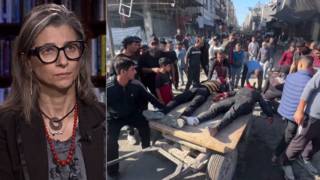
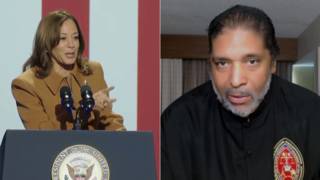

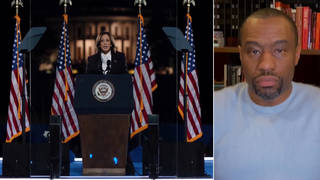



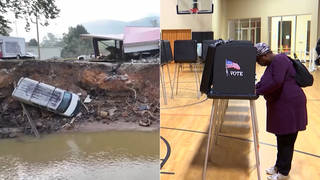


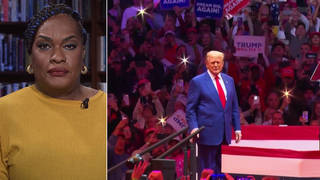
Media Options